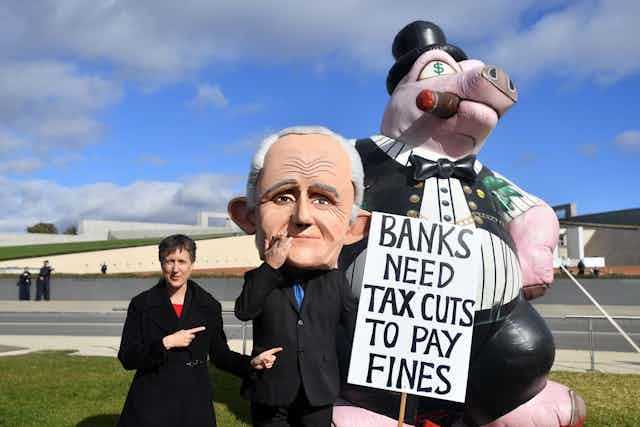This article is the first in the Reclaiming the Fair Go series, a collaboration between The Conversation, the Sydney Democracy Network and the Sydney Peace Foundation to mark the awarding of the 2018 Sydney Peace Prize to Nobel laureate and economics professor Joseph Stiglitz. These articles reflect on the crisis caused by economic inequality and on how we can break the cycle of power and greed to enable all peoples and the planet to flourish. The Sydney Peace Prize will be presented on November 15 (tickets here).
In June 2017, Australia achieved a world record of sorts – 26 years of uninterrupted economic growth. This was achieved with a mix of good luck and good management. The resources boom, prudent fiscal management and some difficult economic decisions guided Australia through the global financial crisis with an economy that continued to grow.
Throughout much of this period, Australia has experienced declining unemployment and growing wages. On the surface this might suggest Australia is a “Goldilocks economy”, avoiding the boom and bust cycle.
However, beneath the veneer it is clear not all have shared in the prosperity generated over the past 27 years. We have seen an enduring rise in economic inequality over the past four decades.
Read more: Don't believe what they say about inequality. Some of us are worse off
Since the late 1970s, there has been a clear and persistent increase in individual earnings and family income inequality. Since the late 1980s, much of the gain in real income has been concentrated at the very top of the distribution.
From an international perspective, Australia now ranks among the more unequal of the OECD economies.
What has happened to pay packets?
A good place to begin to understand how inequality has increased is by examining the labour market. Studies based on Australian Bureau of Statistics and other data sources show a significant increase in wage inequality across workers since the late 1970s.
A range of forces have driven this increase. These include technological change such as computerisation and developments in IT that have fundamentally altered business practices and organisational forms. This has delivered substantial wage gains for some high-skilled workers, while minimal wage growth for low-skilled workers has led to increasing polarisation.
Of course, one of the defining features of the Australian economy over the past three decades has been its internationalisation. Globalisation has exposed more jobs and workers to international competition. This has left some workers, especially the low-skilled, with relatively smaller pay packets.
Read more: How rising inequality is stalling economies by crippling demand
Many institutions are no longer recognisable from those that shaped Australia from the beginning of the 20th century. Unions and centralised wage bargaining traditionally played a pivotal role in protecting the lowest-paid workers’ wages.
Together these forces have contributed to greater wage volatility. The result is that much of the recent gains in real wages have been concentrated toward the very top of the wage distribution.
Families matter
Families can help limit the impacts of the market forces generating inequality. By coordinating work, caring, spending and saving decisions, families can dampen the effects of market-generated volatility and inequality on economic well-being.
Indeed, the rise in earnings and income inequality across families is less pronounced than the inequality across individuals. Nonetheless, “assortative matching”, whereby individuals tend to partner with a similarly educated and skilled individual, has led to a growing gap between the resources of the “haves” and “have-nots”.
The state’s helping hand
As in other countries, there has been a general trend of the Australian state providing less social protection and so acting less as an “equaliser”. For the unemployed, the safety net offered by the Newstart program has been progressively diminished. Access to the Disability Support Pension is increasingly restrictive, and delayed access to the Age Pension means these programs have become less generous over time.
Beyond the labour market, changes to the tax codes have reduced the progressivity of the system.
In total, the broad direction of changes to the tax-transfer system in recent decades has been to reduce the equalising influence of the state.
Intergenerational mobility
The high level of economic inequality at a point in time cannot be readily dismissed as an artefact of a dynamic and mobile economy. Research has shown that Australia’s high level of economic inequality is also associated with lower intergenerational mobility.
Recent evidence based on longitudinal data indicates children’s earnings are strongly related to their parents’. From an international perspective, Australia is relatively immobile. This means the economic advantages and disadvantages we see today may persist over future generations.
Read more: The inequality you can't change that lasts a lifetime
One may well ask: is Australia witnessing the end of the “fair go”?
Is it all doom and gloom?
Despite these developments, there is cause for some optimism. Sustained community pressure has led to policy reforms that improved equality. A recent study showed that the one-off 19.5% increase in the Age Pension for singles (7.9% for couples) recommended by the Harmer Review significantly reduced poverty and inequality among the elderly.
The introduction of the National Disability Insurance Scheme in 2012 represents an important expansion of social protection, which may substantially reduce economic inequality.
Community reaction to the evidence presented at the ongoing Royal Commission into Misconduct in the Banking, Superannuation and Financial Services Industry has led to a commitment to increase the funding and powers of corporate regulators.
Similarly, the Gonski Report of 2012 refocused policy debate on school funding toward needs-based models.
These developments have been driven in part by strong community concerns and a recognition that those most in need have missed out on the prosperity generated by over a quarter of a century of uninterrupted economic growth. Together, they provide hope the fair go has not gone forever.
You can find other articles in the series here.

